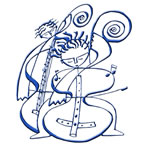
 |
2008 press/reviews | 2007 reviews | 2006 reviews | 2004-2005 reviews | miscellaneous quotes
RAMEAU Ballet Suites - Dardanus; Pigmalion; Platée .
European Union Baroque Orchestra/Roy Goodman
Naxos 8.557490 (super budget price, 1 hour 16 minutes)
Website www.naxos.com Producer Martin Souter Date 2004.
Not only does this disc leave us, in the words of Simon Heighes's compact
but informative notes, 'in no doubt of Rameau's place as one of the most
original dance composers of the last three hundred years', it also reminds
us how powerful and persuasive Roy Goodman is as an interpreter of Early
Music.
The European Union Baroque Orchestra may be a very different ensemble
from those with which Goodman is more usually associated, but he drives
them on to performances notable for their crispness of delivery, clarity
of articulation, conformity of ensemble and conviction of musicality.
Despite the fact that this group is actually three different groups, each
existing for just six months before its 25-or-so young players go off
into the outside world, and that, as a glance through the list of names
reveals, they are drawn from almost as many different countries as exist
in the newly enlarged European Union, Goodman has achieved an astonishing
level of coherence in their playing.
The sound is perhaps a little more weighty and solid than we have come
to expect from a modern-day Baroque orchestra, but some of that can be
put down to the recording. Different venues were used for each of these
three ballets and while Hertford College, Oxford (for Platée ) gives us
clarity and immediacy, the Église Protestante in Brussels ( Pigmalion
) is altogether more bloomy and leads to some loss of definition in the
lower registers. St.Michael's Church, Summertown, Oxford ( Dardanus )
is probably the most ideal, giving a nice halo of atmosphere with no real
loss of detail.
There is no mistaking the youthful enthusiasm of these players. The vivacious
Platée Overture fairly cackles along, with super-charged, high-voltage
playing, while the exuberant 'Tambourins' from Dardanus positively whoops
with high spirits. Indeed, it is in these sprightlier movements that the
players of the orchestra really excel, showing despite their obvious vivacity,
impressive discipline with never a moment's lapse in ensemble, while the
slower movements, such as 'Les différents caractères de la danse' of Pigmalion
, elicit strangely convoluted rythmic twists and turns.
Taken overall, the sheer vitality of the European Union Baroque Orchestra's
playing under Goodman brings these wonderful and largely neglected scores
vividly to life.
(Marc Rochester, May 2006)
La Gaceta de Salamanca, April 2006
EUBO with The Hilliard Ensemble and the Choir of New College Oxford performing Bach's St John Passion
Scherzo, January 2006
Review from Auditorio Municipal Maestro Padilla, Almeria, Spain
As
part of the cycle of great concerts organised by Almeria’s cultural office,
EUBO presented during their European tour a programme dedicated to real
treasures of the Italian baroque. It included a selection of composers
normally in the shadow of their better known and popular contemporary
Antonio Vivaldi. From his repertoire EUBO performed N°7 and N°11 from
the “L’estro armonico” and the violin concerto “Il grosso mogul”, less
played in concert halls but well known by lovers of baroque virtuosity
- with the paradox of not having any Italian among the seventeen members
of the group.
The high level of accomplishment in this project, with twenty years of
history behind it, stood out with the British musician Rachel Podger,
specialist in baroque violin at the prestigious Guildhall School of Music
and Drama in London and at the international Sommer Akademie in Innsbruck.
Her entire performance clearly showed her intention to turn her interpretation
into a master class for all the orchestra members and a pleasure for the
public.
The rendition of the concerto for four violins by Torelli showed the level
of balance reached by this group as one of the essential aims developed
in their time working together. The abstract, evocative character of the
piece was well reflected with a treatment full of precise delicacy. The
same was true of with the sonata N°XXV by Stradella, a true concerto grosso
for two violins, theorbo and orchestra that represents a small treatise
with rules and precise instruction for interpretation.
The rapport and versatility of the group was manifest brilliantly, leaving
the audience with a great sensation.
In the other concerto for four violins, Op.4 N°12 by Locatelli (preceded
by the spectacular “Il grosso mogul”, mentioned above), Rachel displayed
all her proficiency, revealing the extent of her virtuosity, always well
supported by the orchestra. One of the most solid of Vivaldi’s compositions,
the penultimate concerto of the “L’estro armonico” closed this concert,
full of precise playing, where the musicians that took part showed their
very good training and artistic quality, the German doublebass player
Barbara Post standing out.
(Jose Antonio Canton)